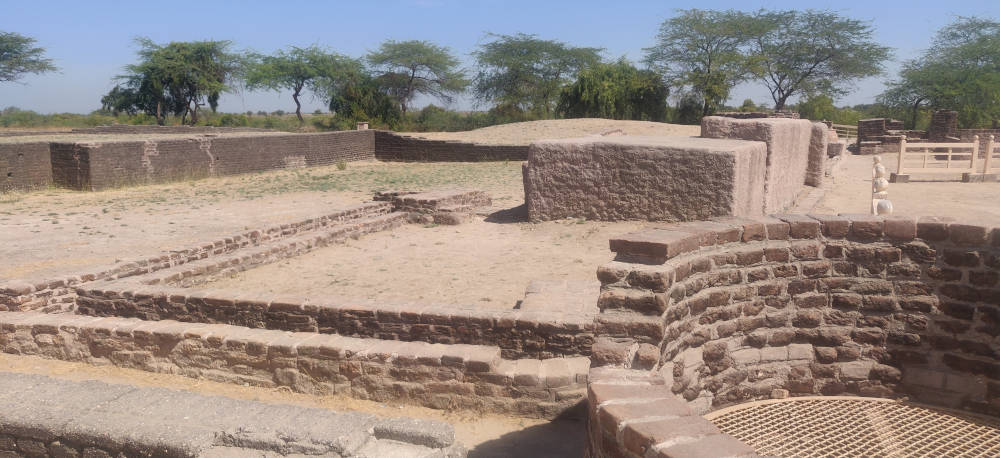[An ancient well, part of the planned water management system at Lothal]
There’s something majestic and magnetic about the Harappan civilisation, especially for Indians. We first encountered it in our school textbooks: street grids, sewerage systems, mysterious seals, delicate figurines, and the great bath at Mohenjo-daro. Even as children, we felt an odd pride in its sophistication, without quite knowing why. After all, the civilization’s marquee cities now lie across a dusty border, in modern-day Pakistan, out of reach and out of sight. Growing up, the Indus Valley civilisation became more legend than locality — symbols of an ancient brilliance we knew we belonged to, but couldn’t physically touch.
Then recently, we heard whispers of Lothal. Of Dholavira. Of Rakhigarhi and Kalibangan and sites still being unearthed in India itself, across Gujarat, Haryana, Rajasthan, even UP. We learned that this wasn’t a civilization confined to the Indus alone, but one that had flourished along the now-vanished Saraswati — a river that sits somewhere between map and myth. (This was particularly poignant for me, since I was born into a Saraswat family). The debate around the Aryan migration — or invasion — overlays this terrain like a second coat. The more one digs, the more intriguing it becomes: a civilization advanced in city planning, yet undeciphered in script. A past that feels personal, yet remains elusive. And so we return, again and again, to the sunbaked ruins and salt plains, longing to brush against a history that still hums beneath the surface and just over the horizon.
Little wonder, when a close friend, Sam Selvakumar, proposed a 5-day curated trip to two Harappan sites — Lothal and Dholavira — with a bunch of like-minded pals, I jumped at it! Our little group (we call ourselves ‘The Odyssey Outbound Explorers’) consisted of six people from Bangalore and one each from Chennai and Mumbai, plus our two raconteurs from Carnelian Travels — Meera Iyer and Aravind Chandramohan.
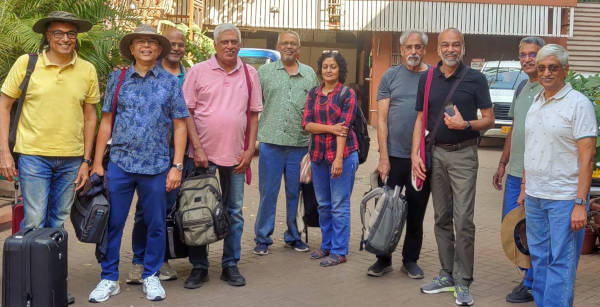
[The outbounders, ready for our odyssey]
[To read the story map on full screen, click here.]
Day 1 - 14th Feb, 2025: Ahmedabad
“Cities provide something for everybody, only because, and only when, they are created by everybody.” — Jane Jacobs
Ahmedabad, at first glimpse, is a swirl: laundry lines strung over 500-year-old havelis, glassy skyscrapers peeking over ancient mosques, scooters humming past pushcarts piled with cumin, coriander and other spices. It feels lived-in and layered.
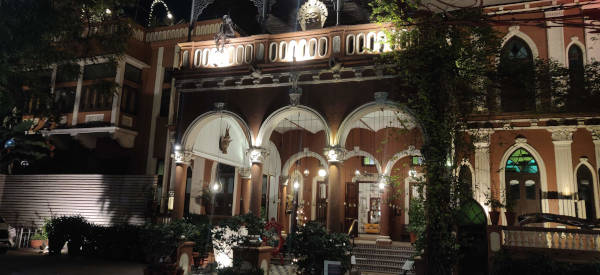
[The charming & eccentric House of MG hotel]

[A lovely corner for chai and the morning paper at the House of MG]
Our first halt was at the much-talked-about House of MG — a charming heritage hotel located at a busy junction. This sprawling, lovingly restored mansion was once a government office, then the home of a wealthy Gujarati textile magnate, Mangaldas Girdhardas. It now stands as a tribute to Indo-Gothic architecture and cultural preservation. The restoration clearly revealed its quirks: some bedrooms were tucked away in the basement; one even featured a rather peculiar ‘mezzanine toilet’! Nevertheless, it was a delightfully eclectic place, worth at least a one-time stay for its character alone.
To stretch our legs, we set out for a guided walk through the old walled city, braving peak evening traffic. Our path wound through narrow, chaotic lanes where crumbling old buildings jostled for space with speeding motorbikes and impromptu street-markets. We passed the stately but now-abandoned Ahmedabad Stock Exchange building — a grand relic laid low by the rise of electronic trading. As we trudged on, we couldn't help but notice a surreal Valentine’s Day motif: endless rows of hawkers selling garish red lingerie on the footpaths!
Our (most excited & excitable) local guide explained the concept of ‘Pols’ — traditional, self-contained neighbourhoods, often organized along caste, religion, or profession. These closely-knit and higgledy-piggledy urban clusters are a defining feature of old Ahmedabad.
We soon found ourselves at the main gate of the walled city, founded by Sultan Ahmad Shah in 1411 AD. One delightful anecdote stood out: just inside the gate is a shrine to Goddess Lakshmi, maintained and worshipped daily by a Muslim family for generations. We met the current caretaker — a Muslim priest performing rituals for a Hindu deity. In a city scarred by the 2002 communal riots, this gesture of interfaith harmony felt quietly profound and reassuring.
We stopped by the Jama Masjid, just across from the House of MG. Built in 1424 during the reign of Ahmad Shah I, it remains one of the most exquisite mosques in India, known for its Indo-Islamic architectural style. Glowing golden at dusk, the mosque was all symmetry and light, teeming with worshippers offering Friday prayers.
After a delicious Gujarati thali dinner — a veritable carousel of flavours — we called it a night.
Day 2 - 15th Feb, 2025: Lothal
“The past is not dead. It is not even past.” — William Faulkner
After a hearty breakfast, Meera briefed us on our visit to Lothal, one of the most prominent cities of the Harappan Civilization, dating back to 2400 BCE.
We boarded our trusty 14-seater Force Urbania — that would serve as our ride for the rest of the trip. At the wheel was Kanti-bhai, our ever-smiling, supremely competent driver. The drive took around two hours over Gujarat’s impressively smooth highways.
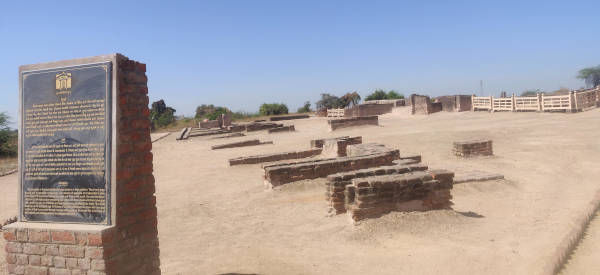
[The Acropolis (royal residential area) at Lothal]
We arrived at Lothal under a blazing mid-afternoon sun, but the heat didn’t dampen our curiosity. My first impressions: there is no glamour here, no polished marble or dramatic pillars. But the scale, ingenuity, and stillness are staggering. Meera led us through the site, pointing out the remains of residential quarters, workshops, bead-making units, and — most impressively — the dockyard, believed to be one of the world's earliest known. This massive, trapezoidal structure once connected to the Gulf of Khambhat via an ancient channel. We stood where ships arrived from Mesopotamia and beyond, where merchants once traded goods and ideas, over 4,500 years ago. It is stunning to contemplate that this port, from a time before iron, before empires, was somehow engineered with such astonishing precision. According to local folklore, Lothal was a city that could “hear the sea” viz. it lived in tune with the sea. Another interesting anecdote: The name Lothal derives from Loth + thal, meaning "mound of the dead" in Gujarati. This might well be influenced by the better-known Mohenjo-daro (“mound of the dead” in Sindhi)
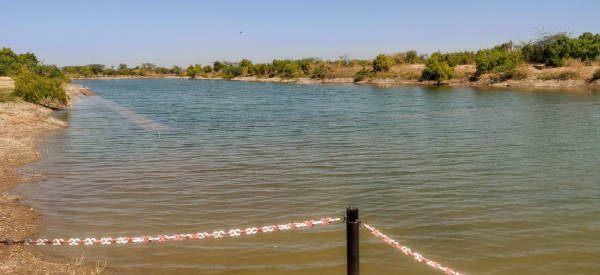
[The dockyard and shipping channel at Lothal, visible underwater.]
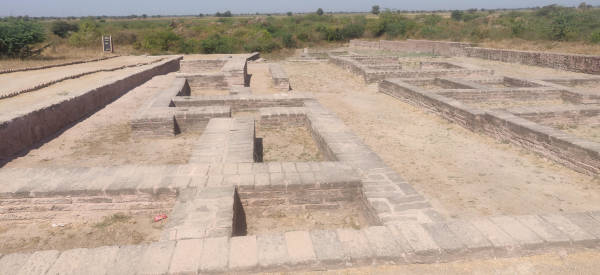
[The marketplace, with shops facing the street & workshops/ residences behind.]
After spending about 2 hours at the site, we enjoyed a simple and satisfying lunch at a highway restaurant. We soon discovered a delightful pattern: even the humblest roadside dhabas in Gujarat offer a smorgasbord of all-veg cuisines — from South Indian to Western to Chinese, with a noticeably Gujarati/sugary twist!
Later, we arrived at the Ferns Sattva Resort — a surprisingly plush oasis in semi-arid surroundings. We gathered on the lawns under a sky full of stars. A few bottles of red wine were uncorked (we took our chances!) and soon the lawn was filled with laughter, stories, and the unmistakable clink of holiday cheer.
Day 3 - 16th Feb, 2025: Dasada (Bird & Wild Ass Sanctuary)
“In the wilderness lies the preservation of the world.” — Henry David Thoreau
Nature Day began early, with a Jeep safari into the Little Rann of Kutch, a UNESCO Biosphere Reserve. As we boarded our open-top off-road vehicles, someone quipped about seeing "wild asses" — prompting juvenile giggles among the seniles.
The landscape was strange and lunar: vast sandy plains, dotted with saline marshes. We were greeted by a spectacular display of birdlife: flamingos, painted storks, egrets, drongos, and many more. A few lucky ones among us even spotted a small herd of nilgai.
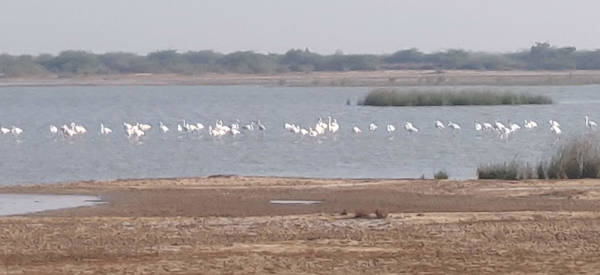
[The saltwater marsh is teeming with migratory birds]
Further into the sanctuary, we finally encountered a herd of the famous Indian Wild Ass (Equus hemionus khur). We were able to get quite close, to see their unique mauve-and-cream colouring and proud stance. They looked part unicorn, part desert horse — though they didn’t seem in a hurry to go anywhere. Unfortunately, their attitude rubbed off on one of our Jeeps, which refused to start on the way back!
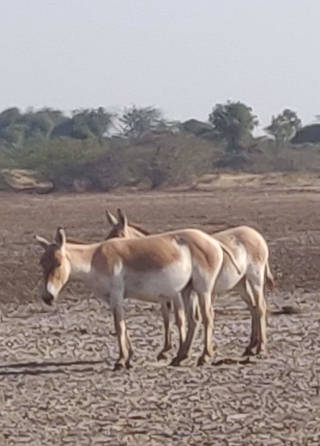
[The (in)famous Indian Wild Ass]

[Truly the salt of the earth]
Soon we reached the salt pans and met the Agariyas — salt farmers whose gruelling work stretches from monsoon to summer. A single pan demands 7 months of backbreaking manual labour and yields over 500 tonnes of salt annually. They are quiet heroes and their smiles were tired, bright, unvarnished. Very humbling for us city-folks, so used to our comforts, conveniences and luxuries!
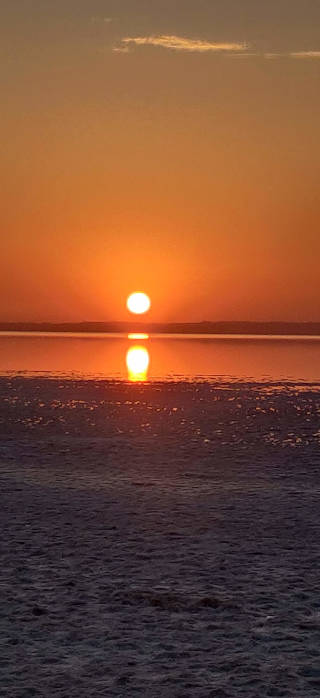
[Lucky to catch this magnificent sunset]
After lunch, we drove for six long hours to Dholavira, aiming to catch the sunset. We made it just in time. The White Rann stretched out like an infinite sheet of salt — crunchy underfoot and shimmering in the golden light. The setting sun turned a white canvas into a blushing pink. It felt otherworldly, like walking on snow under a tangerine sky. Echoes of Tatooine and Arrakis!
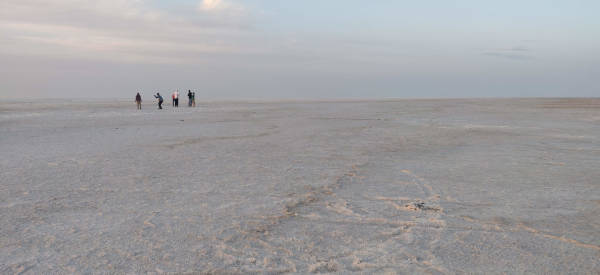
[The immense salt flats of the White Rann]
We checked into the nearby Evoke Dholavira Resort, tired but glowing.
Day 4 - 17th Feb, 2025: Dholavira
“Civilizations die from suicide, not murder.” — Arnold J. Toynbee
Today was the centrepiece of our trip — Dholavira, one of the most significant Harappan sites discovered in India. Located on the island of Khadir Bet in the Great Rann of Kutch, this site was occupied from 3000 BCE to 1500 BCE.
As we drove up, I found the landscape bleached and quiet, as if holding its breath. From a distance, the site looks unassuming — low mounds and dusty outlines — but as we stepped on the weathered stones, the grandeur was unmistakable. Sunlight poured into precisely built public grounds, while the fortifications stood in silent defiance of time. There were no crowds, no sign boards — just the hot breeze, the salt in the air, and a sense of trespassing into the memory of something much greater than us. A civilisation shaped by stone and defined by water.
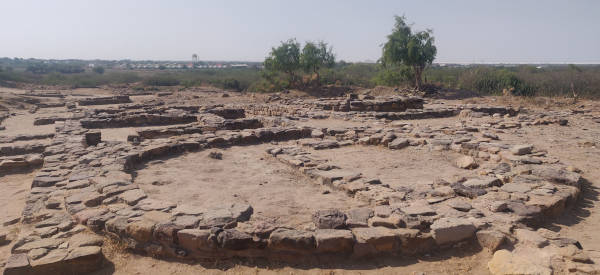
[The Citadel. It is unclear what these circular stone formations were used for. They are different from the predominant straight lines and right angles found elsewhere.]
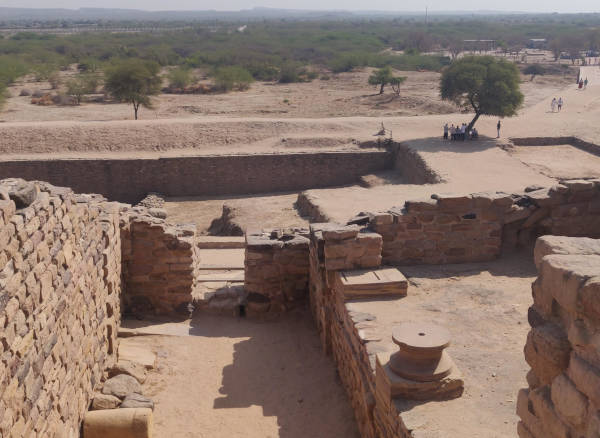
[One of three massive water reservoirs, viewed from the Citadel’s ramparts]
The town layout is a true marvel: an impressively sturdy Citadel with its own water reservoirs, a man-made dam, and bailey; a Middle Town, Lower Town and cemetery; an ingenious drainage and sewage system; and even evidence of signage written in the still-undeciphered Indus script. We saw bead workshops, markets, and warehouses for exquisite artefacts — terracotta, gold, ivory, and semi-precious stones like Carnelian, which gave Meera and Aravind's company its name.
The sophistication of urban planning here could rival modern towns. There is strong evidence of trade with Mesopotamia and the Arabian Peninsula, making Dholavira a crucial node in ancient commerce.
Meera's thematic approach — "Water and Trade" — made everything click into place. We had lively discussions about the civilization’s enigma: a culture advanced enough to design and build such marvels, yet whose language we still cannot read. Who will find the Harappan equivalent of the Rosetta Stone, we wondered.
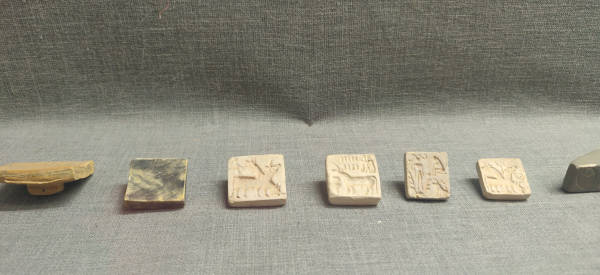
[Ancient clay and terracotta seals; what they convey remains a mystery.]
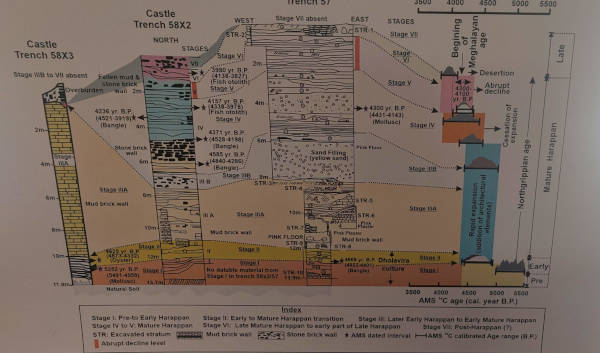
[Painstakingly documented excavations go 40 feet deep.]
The on-site museum added depth and detail with scale models, artefacts, and immersive exhibits. Kudos to the Archaeological Survey of India (ASI) for their exceptional excavation and preservation efforts.
We were quite overcome, absorbing the beauty in the precision and the tragedy in the silence. We spent almost four hours at Dholavira and could have easily stayed longer.
We drove towards Bhuj, via the stunning ‘Road to Heaven’ — a 25-kilometre stretch flanked by pristine white salt flats, under an endless sky. With music on the stereo and salt stretching to the horizon, it was one of those magical travel moments. To mark the occasion, we listened to Led Zeppelin’s “Stairway To Heaven” & AC-DC’s “Highway to Hell” (the latter is definitely a lot more crowded!)
Our night halt, Kutchi Courtyard, was a quaint, luxurious homestay with just seven rooms. Our host family was most gracious and hospitable. Cosy, colourful, and beautifully decorated, it was completely ours for the night. Over our last bottles of wine and a delightful dinner, we recapped the journey so far.
Day 5 - 18th Feb, 2025: Bhuj
“We shape our buildings; thereafter they shape us.” — Winston Churchill
It was Palace Day. Bhuj, severely impacted by the 2001 earthquake (80,000 buildings were destroyed or damaged), still bears traces of its past glory. Our local guide gave us a snapshot of the once-prosperous Kutch royal dynasty.
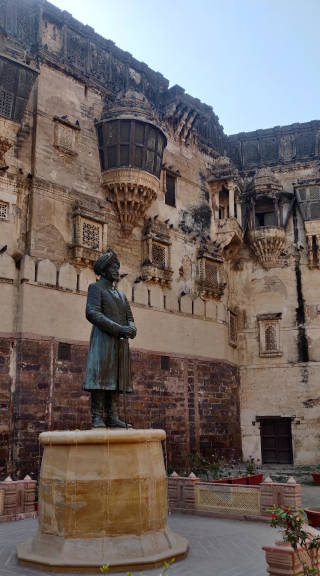
[Bhuj’s Old Palace, where the royal family used to live]
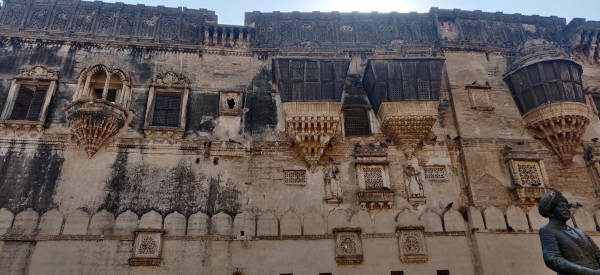
[Beautiful jharokhas, added over the centuries, resulting in a mish-mash of architectural styles]
We visited the Old Palace, which looks tired, but noble and is still under restoration. The adjacent Aina Mahal (Palace of Mirrors) was filled with dazzling artefacts — inlaid mirrors, musical instruments, furniture — all reflecting an Indo-European style blend. Nearby is the more functional New Palace, home to the Durbar Hall, whose stuffed lions however, looked like they’d seen better days — a good metaphor, perhaps, for monarchy’s faded and moth-eaten grandeur.
Outside, a few of us browsed local handicrafts. Bhuj is a hub for Kutchi embroidery, mirror work, and bandhani textiles — perfect for souvenirs.
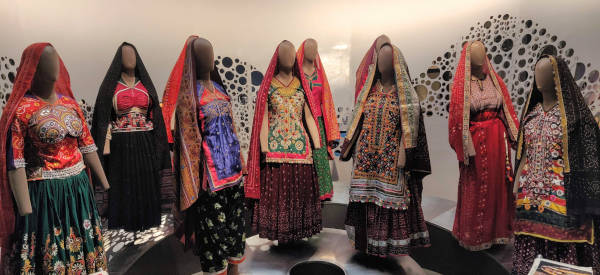
[Captivating dioramas; each costume represents a different artisan community]
Post-lunch, we visited the LLDC (Living and Learning Design Centre) — a hidden gem — and met the hands behind the heritage. This modern museum celebrates 14 traditional artisan communities of Kutch, whose work was on display: vibrant bandhani dots, kaleidoscopic Rabari embroidery, flowing ajrakh prints. The life-size dioramas and hands-on exhibits were mesmerizing, capturing not just textiles but entire ways of life: community, identity, survival. We mustn’t allow these to go extinct!

[Winding down at the Eco-Retreat]
Afterwards, another long drive brought us to our final night halt: the Eco-Retreat. Many of us enjoyed eating non-vegetarian dishes after a few days of ‘deprivation’!
Day 6 – 19th Feb, 2025: Temple Day & Departure
“Architecture is frozen music.” — Johann Wolfgang von Goethe
Our last day, and what a high note to end on!
We explored the breathtaking Sun Temple at Modhera, built in 1026 CE during the reign of Bhima I of the Chaulukya dynasty. As I came closer, the entire complex seemed to be activated by the mighty sun itself: stepped tanks, lotus motifs, deities ablaze in sandstone. I felt as if every figure carved into its walls and pillars might speak to me, if I listened long enough. Its sacred geometry is precisely aligned with the equinox: astronomy and architecture, perfectly choreographed.
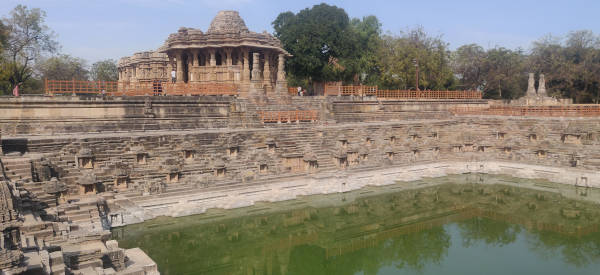
[The Sun Temple with its step-well lined with mini altars]
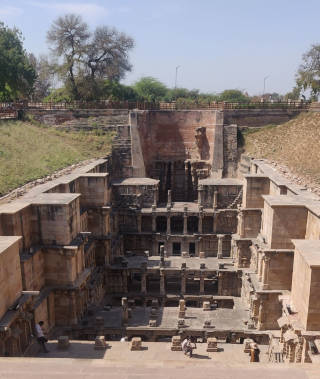
[Most impressive Rani Ki Vav; whose size and scale are deceptive.]
If Modhera uplifts one’s perspective, the nearby and majestic Rani Ki Vav takes the beauty underground. A 11th-century stepwell commissioned by Queen Udayamati in memory of her husband, King Bhima I, this UNESCO World Heritage Site is a gallery of sculpted dedication — over 800 intricately carved figures line its seven levels. Descending into it was like walking into a poem, each layer, a new verse. At one level, the entire set of Dashavatara (Lord Vishnu’s ten incarnations) were just magnificent.
We were spellbound. The blend of function, devotion, and staggering beauty made these places unforgettable. Meera, once again, brought them alive with stories and symbolism.
Finally, we headed back to Ahmedabad airport, reluctant to part ways. Fond farewells were exchanged with Meera and Aravind, and the eight of us shared one last coffee together. There was laughter, gratitude, and already talk of the next reunion — Ajanta/Ellora, here we come!
Themes & Takeaways
- Time-travel between ancient & modern: We experienced what can only be described as a temporal dance moving between eras — from Harappan cities to colonial mansions, from ancient temples to stepwells, from crumbling palaces to contemporary museums. We found it both fascinating, and occasionally disorienting.
- Sacred & Secular Spaces: From shrines in old Pols, to temples and mosques, to interfaith rituals and communal dhabas, we participated in a beautiful and enriching interplay between religion, ritual, and everyday life.
- Preservation & Decay: Most poignant, we noticed the tension between majestic ruins and modern restorations, rich artisan heritage and abject poverty, ecological efforts and climate-stressed terrain. We felt the subtle melancholy and resilience throughout.
- Stones that sing: Whether in ancient citadels, gorgeous temples or earthquake-ravaged palaces, we appreciated mankind’s will to survive and desire to build. Architecture blurs into art, into science, into devotion, and ultimately turns into collective memory.
- Landscapes you can taste: Water & salt. The two most fundamental things needed for survival. Yes, we encountered arid landscapes, but contrary to expectations, we were also soothed by a lot of greenery — there were lakes, canals, and even some thickly wooded patches.
- Journeys within journeys: In a dry state, we somehow found wine. In remote hotels, we found Wi-Fi (and lost it just as fast). In temples and palaces, we found schoolchildren and college students on field trips — dozens of them, filling the corridors with laughter and chatter. It was heartening to see India’s future discovering her past. In most places, we found pride: great roads, clear signage, nice hotels and diligent preservation. We found each other, too. Ten co-travellers became a chorus of inside jokes, snack-sharing, and storytelling. Carnelian’s curation was simply outstanding: Meera, drawing intriguing and thought-provoking connections. Aravind, always armed with timely savouries and sweets, and ensuring we were comfortable at all times.
- Supreme & sublime indifference: Ultimately, we were humbled by the vast desolation, which dwarfs the remnants of human ambition, emphasising the ultimate power of Nature and Time over (relatively insignificant) human endeavors.
Thus ended our first Outbound Odyssey. We returned to our respective homes with sun in our eyes, salt in our shoes, and stories in our hearts.
I leave you with the closing lines from Percy Bysshe Shelley’s immortal sonnet composed in 1818:
‘My name is Ozymandias, king of kings; Look on my works, ye mighty, and despair!’
Nothing beside remains. Round the decay of that colossal wreck, boundless and bare,
The lone and level sands stretch far away.
♦¤♦¤♦¤♦
Travel Tips
- Best Time to Visit: Winter months, from October to February. Daytime temperatures range from 12°C to 25°C. Evening and early morning temperatures can drop to 5°C. Visiting the White Rann during a full moon night is a particularly magical experience. Winter is also when the vibrant Rann Utsav (Desert Festival) is held, with cultural performances, handicrafts, food stalls, and various activities.
- How to Dress: For daytime, pack light, breathable cotton clothes; light colours are preferable to reflect the sun. For evening/nights, pack a sweater, jacket, or shawl. When visiting religious sites/temples, dress modestly; ladies can carry a scarf to cover their heads. Comfortable walking shoes are essential, as are sunglasses, and a wide-brimmed hat or cap.
- What to Carry: Personal medications, wet-wipes, powerbank & binoculars. To stay hydrated, a reusable water bottle is a must.
